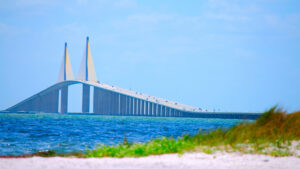By Matilda Pollard, FAU School of Communication and Multimedia Studies
The following is a Q&A conducted with Maya Burke, assistant director of the Tampa Bay Estuary Program. Burke manages the Environmental Restoration Fund in the program and facilitates the Tampa Bay Climate Science Advisory Panel.
What makes Florida unique in its environment?
I think the thing that makes Florida unique is that water is everywhere. It’s really our way of life. It’s how we have fun, it’s how we feed our families and it’s also the thing that’s making us vulnerable to a lot of the impacts of climate change. It’s just sort of central to what makes this place fun and what makes this place sometimes very challenging.

When assessing climate change and the state of the environment today, has any newer information helped with understanding this issue that wasn’t available in the past?
Some of the new information that we’re getting related to climate change has to deal with how temperature change, the frost-free season and sea level rise are sort of coming together to change the composition of our coastal wetlands. Over time, as the climate has changed, we’re seeing more and more of our marsh habitats transitioning to mangrove habitats.
What are the priorities of the Environmental Restoration Fund that you lead and how important is funding and resources for environmental causes?
The Tampa Bay Environmental Restoration Fund is really geared to not only getting public sector dollars, but also leveraging it with money from the private sector communities that are looking to give back. It gives them an opportunity to invest in the health and protection of Tampa Bay. This year for example, we’re soliciting projects that implement “best management practices” for protruding stormwater, particularly in the Old Tampa Bay segment, which is the area of Tampa Bay that has been struggling over the past six years or so. We’re also really focused on habitat restoration.
What does “resilience” mean to you?
For our state we have to be flexible. I think we have to build in that adaptive framework. I think that means we have to invest in real-time monitoring so that we’re able to detect these changes. We need to consider the kinds of projects that are balancing co-benefits. From my perspective, if we can build a piece of infrastructure so that water can flow the way that it did in the 1600s, then we can raise the elevation of the road in ways that make it easier for people to evacuate storms or continue to commute to work if sea levels are rising.

On the Tampa Bay Estuary website, the organization seems very involved with the local community and collaborative efforts like volunteering. What impacts do these community-wide efforts have on climate change and possible improvements?
I think that the Tampa Bay Estuary wouldn’t be in the place that it’s in now if it weren’t for the citizens being involved. We’re designated as an estuary of national significance because the citizens and community members rose up and demanded it of their elected officials. By earning that federal designation, that gets us recurring federal appropriations to ensure that Tampa Bay’s water quality, habitats, all the things are protected. It also provides sort of a binding commitment with the local governments here on the ground that are closest to the people, making sure that our water is clean and that we have thriving habitats that can support the fish and wildlife depending on these resources. I think that the community is a really central part and having that buy-in that ensures that elected officials continue to care and invest in water quality and habitats.
What can the average person do to create healthier habits when a lot of discourse tends to say that large corporations are solely responsible for pollution and the environmental changes?
I think it’s a “yes, and” kind of approach. Yeah, there are structural things going on, but of course there are individual choices we can make to ensure that our environment is the way we want it to look. When it comes to things like nutrient pollution, there are simple choices you can make like skipping the fertilizer in the summertime when it’s rainy and all that fertilizer is going to run off into the surface water bodies, don’t do it. That collective impact from one yard at a time will certainly make a difference in water quality.
If you can do things like drive a fuel-efficient vehicle that has cleaner emissions, if you can skip a trip, or walk or bike somewhere instead, if we can make choices to be more efficient with our transportation these are things that also have a water quality benefit. I think it’s really important for people to be involved and let elected officials know what they support and what they think about water quality, the environment, resilience, all these kinds of things.
Is there anything else you think people should know when it comes to climate change?
Talking to your friends, families and neighbors about climate change is one of the most important things that you can do. If you notice something like, “it feels extra hot this year,” or, “the leaves are changing earlier than they have in the past,” these kinds of observations are things that regular folks make and if you talk about that, it can make a difference in terms of our willingness to tackle these problems together.
This Q&A was conducted by Matilda Pollard, a senior majoring in journalism at Florida Atlantic University.



